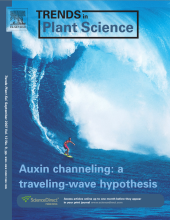Canalization without flux sensors: a traveling-wave hypothesis In 1969, Tsvi Sachs published his seminal hypothesis of vascular development in plants: the canalization hypothesis. A positive feedback loop between the flux of the phytohormone auxin and the cells’ auxin transport capacity would canalize auxin progressively into discrete channels, which would then differentiate into vascular tissue. Recent experimental studies confirm the central role of polar auxin flux in plant vasculogenesis, but it is unclear if and by which mechanism plant cells could respond to auxin flux. In this Opinion article, we review auxin perception mechanisms and argue that these respond more likely to auxin concentrations than to auxin flux. We propose an alternative mechanism for polar auxin channeling, which is more consistent with recent molecular observations.
In 1969, Tsvi Sachs published his seminal hypothesis of vascular development in plants: the canalization hypothesis. A positive feedback loop between the flux of the phytohormone auxin and the cells’ auxin transport capacity would canalize auxin progressively into discrete channels, which would then differentiate into vascular tissue. Recent experimental studies confirm the central role of polar auxin flux in plant vasculogenesis, but it is unclear if and by which mechanism plant cells could respond to auxin flux. In this Opinion article, we review auxin perception mechanisms and argue that these respond more likely to auxin concentrations than to auxin flux. We propose an alternative mechanism for polar auxin channeling, which is more consistent with recent molecular observations.Merks, R.M.H., Van de Peer, Y., Inzé, D., Beemster, G.T.S. (2007) Canalization without flux sensors: a traveling-wave hypothesis. Trends Plant Science 12(9):384-90. |
|
|
Contact:
VIB / UGent Bioinformatics & Evolutionary Genomics Technologiepark 927 B-9052 Gent BELGIUM +32 (0) 9 33 13807 (phone) +32 (0) 9 33 13809 (fax) |
You are visiting an outdated page of the BEG/Van de Peer Lab site.
Not all pages have been ported, so these archived pages are still available.
Redirect to the new website?